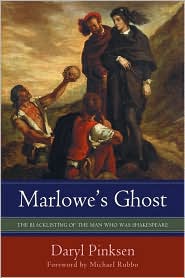On Bastian Conrad’s English language Marlowe pages, I was interested to find a new claim for Marlovian theory that I hadn’t encountered before. From 1602, the title pages of several editions of Venus and Adonis were decorated with an illustration showing a human skull with wings, balanced on the globe of the Earth, and above it an open book containing the words (in modern spelling) “I live to die, I die to live”.
Under
Marlovian theory, Christopher Marlowe faked his death in May 1593 in order to
escape being executed for atheism and heresy, and Venus and Adonis was his first publication under the name William
Shakespeare, so “I live to die, I die to live” might seem a very suitable motto
to place upon it.
Nevertheless
it is vitally important that all researchers seek to disprove their theories,
especially when it comes to theories relating to the authorship question, for
you can be quite sure that if you
don’t attempt to disprove your theory, somebody else will, and thereby cast
doubt on the quality of your pronouncements more generally.
Modern
research tools such as Early English
Books Online make it possible to do this rather easily, if one has access
to them. On examining every digitized title
page for Venus and Adonis that is available, it was
clear that this image was introduced in 1602 by the publisher William
Leake.
A
1599 edition of Venus and Adonis
printed “by R.Bradocke for William Leake, dwelling in Paule’s churchyard at the
signe of the greyhound” did not utilize this image. But William Leake’s 1602 edition, and those
he published subsequently, depicted the winged skull and the open book with its
motto. The reason becomes obvious almost
immediately. William Leake had moved
premises and was now to be found, according to the title page, “dwelling at the
sign of the Holy Ghost, in Paules Churchyard”.
The winged skull was the sign of the Holy Ghost, and “I live to die, I
die to live” was the Holy Ghost’s message of everlasting life.
A
survey of other William Leake publications confirms this; for a decade from
1602, nearly all of his publications bear this image (complete with “I live to
die, I die to live”) on their title pages including:
• John
Jewel’s Sermons (1603)
• John
Lyly’s Euphues and His England (1605)
• Henry
Smith’s Sermons (1605)
• Robert
Linaker’s A Comfortable Treatise
(1607)
• Leonard
Wright’s A Pilgrimage to Paradise
(1608)
Presumably, no one is going to argue that these writers, too, faked their deaths to avoid being killed.
In
1613, Leake changed his device to a wordless, blazing book. But it’s clear that
from 1602 to 1612, the winged skull with its motto that decorated Venus and Adonis – and many other books
besides – was simply a marker of the William Leake brand.
© Ros Barber, February 2015

















